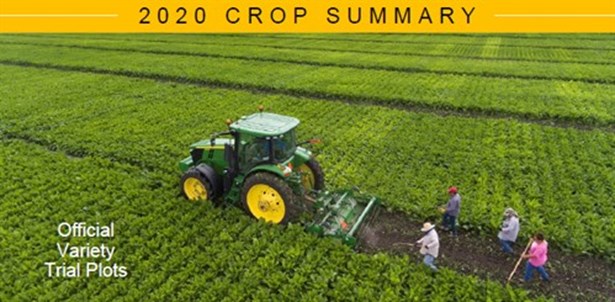615 - 2021 Variety Selection & Production Considerations

Official Coded Variety Performance Trial Data
Many growers have already purchased seed for the 2021 sugarbeet crop, however it is still important to review the OVT data to make sure that the varieties you’ve selected offer the appropriate characteristics of disease tolerance, yield and sugar quality for placement in each unique field on your farm.
OVT trial data can be downloaded in a PDF document or an Excel file. Both have the same data sorted in 8 different ways. Color coded disease tolerance ratings can help you distinguish between the different degrees of tolerance.
OVT data is sorted the following ways (each on a separate page):
• Seed Company
• Rev/Ton
• Rev/Acre
• Aphanomyces Tolerance Rating
• Rhizoctonia Tolerance Rating
• Fusarium Tolerance Rating
• Cercospora Tolerance Rating
• Emergence Percent
Downloading the Excel version will allow you to create your own sorts to examine the data as well.
Considerations on Variety Placement
- Historical variety performance on your farm.
- Known disease presence in fields to be planted in 2021.
- Production characteristics by field:
- Below average sugar and/or above average tons – consider higher sugar variety to optimize recoverable sugar/acre.
- Above average sugar and/or below average tons – consider higher yielding variety to optimize recoverable sugar/acre.
- Pre-piling from designated fields, headlands and splits – use high sugar varieties to maximize your Pre-pile Premium
- Field distance from piling site/factory – if long distance, consider higher sugar, moderate tonnage varieties to help lower transportation costs.
Township Disease Severity Maps & Recommendations
Links to general observations on disease presence & management recs for:
Production Considerations in 2021
The 2021 crop has both optimism and challenges to prepare for.
- Compared to recent years, fall fieldwork and fertilization has been completed on many of the planned 2021 beet fields.
- Drier soil conditions point to a possible early and timely planting opportunity, if winter and spring moisture levels remain cooperative, creating great crop potential.
- However, the soil profile will need to be recharged with adequate moisture.
Glyphosate Resistant Weed Control
- All areas of the Red River Valley need to have a plan to control glyphosate resistant weeds, particularly waterhemp.
- This plan should incorporate a layered approach to soil applied herbicides, and this approach could include a PPI/PRE herbicide application along with 2 POST Lay-by herbicide applications.
Sugarbeet Root Maggot Footprint Continues to Expand
- The best treatment is using Counter insecticide At-Plant followed by POST insecticide applications.
- Some areas may require multiple POST applications for optimal control to reduce the number of flies laying eggs.
High Cercospora Inoculum Levels
- The high level of Cercospora Leafspot (CLS) infections in 2020 has produced robust Cercospora inoculum levels for 2021.
- A timely initial fungicide application will be needed to delay and push back the on-set of Cercospora infections and there-by reducing its potential severity.
- Tank-mixing and rotating fungicides continues to be a critical practice as well as maintaining proper fungicide application intervals.
- Planting varieties with good CLS ratings can make a big difference in infection levels.
